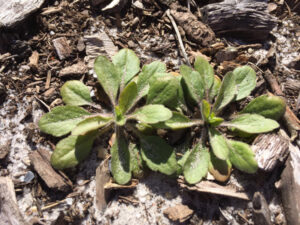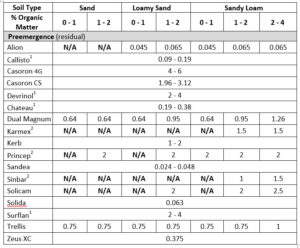Thanks to field research conduct by the Rutgers Specialty crops Weed Science lab and funded by Rutgers NJAES, Bayer CropScience, and the NJ Blueberry and Cranberry Research Council, Alion® herbicide received a FIFRA 24(c) Special Local Need label from the EPA and the NJDEP for use ONLY on dormant highbush blueberry in sandy soils containing greater than 1% organic matter. The new 24(c) Special Local Need label can be found on the Agrian website here.
Alion® (indaziflam) is a Weed Science Society of America (WSSA) group 29 cellulose biosynthesis inhibitor in the alkylazine family. The FIFRA Section 3 label of Alion® allows its use on blueberries that have been established for at least one year but prevents its use on soil with ≥ 20% gravel content or on sandy soil, regardless of soil organic matter content. Thus, prior to receiving the new 24(c) Special Local Need label, Alion® could not legally be applied on New Jersey blueberries that are primarily planted on sandy soils.
The new 24(c) Special Local Need label allows directed application to the soil beneath blueberry bushes planted on sandy soils with some important restrictions:
- Only apply Alion Herbicide to soil as a dormant application in late fall through early spring before bud swell.
- Do not use Alion® in highbush blueberry crops grown in sand containing <1 % organic matter content.
- Do not use on soils with 20% or more gravel content.
- Do not apply more than a total of 10 fl oz product/A (0.13 lb ai/A) per year on sand containing ≥1 % organic matter content in a 12-month period when used in any highbush blueberry.
- Do not allow spray to contact green stems, foliage, flowers, or berries or unacceptable injury may occur.
- When making more than one application per year, allow a minimum of 90 days between applications.
Alion® provides excellent and season-long residual control of annual grasses and broadleaf species due to its long soil persistence with half-life greater than 150 days and low water solubility under acidic soil conditions. Results of a 3-years study conducted on three different blueberry cultivars (Duke, Bluecrop, and Elliott) at the Rutgers P.E. Marucci Center demonstrated that repeated fall or early spring applications of indaziflam at the 5 fl oz/a labeled rate did not cause injury or reduce commercial yield of blueberry grown on sandy acidic soil. Data generated through this research also showed that fall application of indaziflam consistently provided better weed control than spring applications for species such as horseweed, large crabgrass or narrowleaf goldentop. This suggests that Alion® applications in New Jersey should be restricted to dormant bushes during the fall season in order to maximize weed control effectiveness while maintaining the highest level of crop safety as compared to spring application. Alion® has no activity on sedge species or perennial weeds. Therefore, it is important to consider rotating to different herbicide modes of action after 1 or 2 years of Alion® application to avoid selecting for weeds that are not controlled by Alion® and prevent potential development of herbicide resistance to indaziflam.


